«previous pageANALYSIS & PLANNING CATEGORY
Wild North vs. Rational Port Landscape Architecture Articulates a New Northern Portscape Near Moosonee, Ontario
University of Toronto, Toronto, Canada
faculty advisor: Jane Wolff
Project Statement
This design envisions a new northern port that uses a circular formation to reframe the dialogue between public and private port functions. As the spatial backbone for both water and land functions, my alternative port design invents a circular spatial backbone to connect port spaces with habitat nodes, to provide various forms of local recreation and occupation, and to mitigate ballast water pollution. This dynamic infrastructure allows for the pairing of hyper-optimized port functions with northern ecological conditions.
Project Narrative
Introduction
The North is changing and the ships are coming. The continuing ice melt of the sub arctic and arctic regions of Canada is transforming the North into a new place. How will these new lands transform and what opportunities will these transformations lend us? Perhaps the invention of new northern ports is a vehicle in which to capitalize on the effects of climate change. What if we create several northern ports each functioning in a different distribution capacity? With this economic thrust and infrastructural base, Canada can become newly linked with its northern identity. I propose a new form of northern port in James Bay, Ontario that will allow for its dual use as an intermodal distribution hub and a public northern landscape. My proposal articulates the imposition of the rationalized port on the wilderness through a circular form; the outer edge of the curve satisfies the port functions and logistics while the inner edge provides a sheltered harbour on the found landscape. This dynamic infrastructure allows for the pairing of hyper-optimized port functions with northern ecological conditions. The ice is melting and the ships are coming to the wild north.
Objective
The objectives of the design are manifold.
- To locate the most optimized position economically and ecologically for a Canadian port; a site where the largest ships may sail the closest to the production and import regions before having to transfer cargo to trains. This would allow for the trading of Canada 's exports and global imports with the least amount of fuel.
- To realize a port formation that remains accessible and useful to the local community. In a northern Ontario setting, these needs include waterfront access for both recreation and commerce, consideration of winter use for trapping, travelling, and recreation, and attention to the need for a strengthened local tourism infrastructure.
- To provide a system within the port landscape to mitigate ballast water pollution and to connect habitat nodes such as water fowl grounds and migration routes.
Analysis
The initial analysis examined the logistics and nature of port spaces. Fundamental findings from this analysis were the discoveries of just how alienating and disjointed port facilities have grown, how few public access points to the water ports afford, and how underutilized landscape processes were in the mitigation of port pollutants. Ports have become restricted by the growing cities surrounding them and are struggling to manage the demands of containerization. As a result, port operations are fragmented and inefficient.
Further analysis developed an understanding of the social and economic needs of northern Ontario communities. In Moosonee, the community struggles to gain economic independence from the south of Ontario and is under serviced in terms of infrastructure that can strengthen thier economic condition.
My analysis went on to consider the ecological systems and processes involved in the northern boreal ecosystem and the effects on this system of climate warming. It is thought that the boreal forest is highly vulnerable to climate change, however little is understood about how these forests would react to temperature changes. This is due in part to the difficulty of gathering data in remote areas.
Site
I focused on the lower James Bay region in Ontario as a site for a new port that not only links the North West Passage to the great lakes region, but also connects the grain and potash producing provinces to the new northern port. Through site analysis I discovered that Moosonee Ontario is well suited to a port. From Moosonee five days of transit time is saved shipping from the west and almost two weeks is saved shipping from the east. The bay is deep and is predicted to remain seasonally ice-free for 6 months of the year by 2050. The terrain is flat which is needed to stage port functions, such as rail yards, and the site is already connected to the Ontario Northland railway. I also began to understand this place as a hub in its own right. The lower James Bay region is unique in Canada in that it offers a gateway between the boreal forest and arctic tundra. It is the furthest place south in Canada where you may encounter polar bears, caribou, and beluga whales. It is also a migrating bird refuge and a stage for other natural phenomena such as the northern lights and ice break up.
Design
Based on my analysis of ports and the James Bay region, I began to think of ways in which to optimize port functions in terms of the efficient transfer of goods. This led to a design strategy which consolidated the various goods that would move through the port of Moosonee into five zones: liquid and dry bulk, break bulk or odd sized shipments, containers, cruise passengers, and mechanized products that roll on and off ships. I then began to think of these zones in term of the time it takes to load and off load the ships, transfer goods to trains, and then to move the trains away. In Moosonee there is the luxury of space in which to stage train movements and optimize the quick transfer of goods. The most efficient route for these movements was a circle where trains could easily move throughout the zones with out having to back up. This logic evolved into a spatial arrangement where trains would be able to service a ship in loading queues, and then easily reconnect to the main circular rail spine.
With this strategy the manifold benefits of the form were developed. A circular form allows for a microclimate on the interior of the port that could serve as a public inner harbour. The inner harbour is sheltered from waves and wind and provides easy access to the shoreline and bay for the community. The form also provided a panorama from which to view and experience the port. The ship decks, arranged on a curve and sloped toward the interior can serve to collect surface runoff and ballast water into container holds. The design evolved to include programs integral to the experience and function of the port, such as wetlands, a landform and a breakwater. A major pollutant from ships is ballast water. This water is unique in that it contains oils and other effluents as well as problematic bacteria and viruses. Specific wetlands are constructed at the edge of the port landscape to mitigate the ballast water. A UV settling pond manages and destroys the bacteria and viruses, free water surface wetlands remediate organic compounds and a subsurface wetland continues these processes throughout the winter. The landform provides the necessary gravity to conduct ballast water through the final remediating wetlands as well as providing a large park space from which to view the port. The breakwater serves to protect the outer harbour form winds and the accumulation of river sediment and is designed as a public causeway accessible by car or foot. The design evolved to include roads connecting the port to Moosonee, and to provide public access to the interior harbour. With linkages and connections to other communities and the region, an opportunity to research climate change became evident. Incorporated into the infrastructure of the constructed wetlands are berms planted with blocks boreal species. The vegetation groups may be easily accessed and monitored over time as an investigation into the affects of climate change on boreal species.
The design as a whole may be understood at its centre. Here, the circular port, its landform, and shoreline meet at the dynamic interface between industrial activity and landscape process. At the shore, ballast water returns full circle to the bay from the slopes and undulations of the landform into the panorama of the port.
Additional Project Credits
Many thanks to Arifa Shompa Hai for her wonderful vegetation hand drawings, Alec Hawley for his valued support and help with renderings, to both Todd Smith and Lea Carlson for their great help with section drawings, and to John and Bonnie Likins for their amazing support, advice, and critical eye.
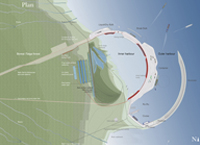
Plan (Photo: Courtney Likins)
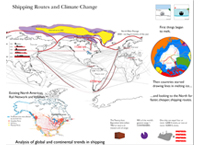
Shipping Routes and Climate Change. Analysis of global and continental trends in shipping. (Photo: Courtney Likins)
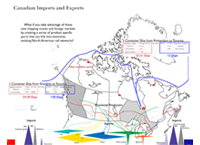
Canadian Imports and Exports. What if you take advantage of these new shipping routes and foreign markets by creating a series of product specific ports that can link into extensive, existing North American rail network? (Photo: Courtney Likins)

James Bay Region. Site analysis and site selection. (Photo: Courtney Likins)

Ports. Analysis diagram of diversion of goods directed to Moosonee and comparison of Canadian port layouts. (Photo: Courtney Likins)
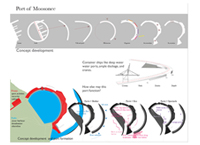
Port of Moosonee. Concept development and port formation. (Photo: Courtney Likins)

Oblique perspective looking across the port towards the Moose River. Employment impacts from the port will be well over 1250 full-time jobs annually, increasing the population of Moosonee from 2500 to approx. 4250. (Photo: Courtney Likins)
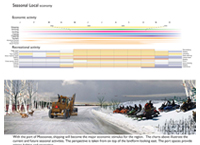
Seasonal Local economy. With the port of Moosonee, shipping will become the major economic stimulus for the region. The charts above illustrate the current and future seasonal activities. The perspective is taken from on top of the landform looking east. The port spaces provide winter habitat and recreation. (Photo: Courtney Likins)
"Ingenious and alluring! The analysis is excellent and the planning keys off that beautifully. A really nice project."
— 2009 Student Awards Jury
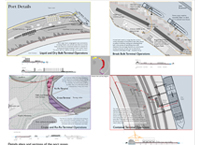
Details plans and sections of the port zones. (Photo: Courtney Likins)

Sub surface wetland. Section and perspective describing the wetland systems that mitigate ballast water. (Photo: Courtney Likins)

UV Retention Pond. Sections describing the first two stages of ballast water remediation, the UV system and the FWS systems. Tree species from the boreal forest can grow on the wetland banks where there is good drainage. (Photo: Courtney Likins)
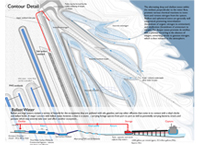
Contour Detail. The alternating deep and shallow zones within the wetland, perpendicular to the water flow, promote various chemical reactions to transform and remove nitrogen from the system. Shallow and ephemeral zones are generally well oxygenated, promoting mineralization (breakdown of organic nitrogen to ammonium) and nitrification (breakdown of ammonium to nitrate). The deeper zones promote de nitrification, a process occurring in the absence of oxygen, converting nitrate to gaseous nitrogen, which is then released to the atmosphere. (Photo: Courtney Likins)

Destination for natural phenomena. The port of Moosonee is situated within a natural gateway of beluga and seal habitat, and bird, polar bear, and caribou migration paths. The landform helps some of these animals find passage through the portscape as well as providing a vantage point from which to experience these spectacles. (Photo: Courtney Likins)

Perspective illustrating various types of recreation and experience afforded by the port and the landform. The above image shows the final stage wetland on top of the landform, the trails within, and the wetland cells. The lower image describes the micro climate found within the inner harbour and the access to the harbour from a swing bridge. (Photo: Courtney Likins)
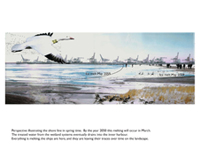
Perspective illustrating the shore line in spring time. By the year 2050 this melting will occur in March. The treated water from the wetland systems eventually drains into the inner harbour. Everything is melting, the ships are here, and they are leaving their traces over time on the landscape. (Photo: Courtney Likins)



